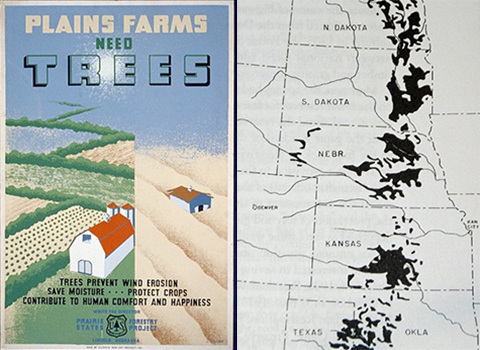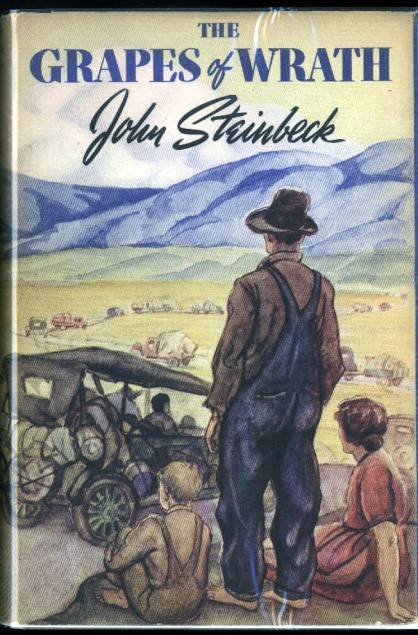
In two earlier episodes, we talked about the greatest environmental disaster in U.S. history: the Dust Bowl, which killed thousands and left millions homeless.
It happened when the Great Depression and prolonged drought coincided, causing farmers to abandon their fields across the Great Plains.
Winds carried a billion tons of soil into the air, creating devastating dust storms that blew across the country.
The Dust Bowl era began in 1931. What ended it?
As early as 1933, the government established soil erosion camps in the region. They dispatched thousands of workers to rehabilitate millions of acres and began to teach farmers how to protect their soils.
In 1937, they stepped up these efforts, paying farmers to practice more expensive soil preservation techniques, like terracing, crop rotation, no-till farming, and planting cover crops.
Within a year, this massive effort had reduced soil loss by 65 percent. But farmers still struggled.
So the government began the Shelterbelt Project. It planted 200 million trees in a hundred-mile-wide belt from Texas to Canada, to contain soil and water and protect farms from wind.
It remains the largest environmental remediation project in American history.
Finally, in 1939 the rains returned, and the drought ended.
Wiser, crisis-hardened farmers began growing crops again, using methods to better resist droughts common to this region.
Background
Synopsis: The Dust Bowl of the 1930’s lasted nearly a decade and displaced millions of people from the Great Plains, resulting in America’s largest migration in a single decade. Amid the human suffering, many lessons were learned about the causes of dust storms and how to mitigate their impact, from better crop management to planting trees. Stories were told in the songs of artists like Woody Guthrie and in books like John Steinbeck’s award-winning The Grapes of Wrath.

- In the previous two episodes of EarthDate, “Dust Bowl 1: Storm Brewing” and “Dust Bowl 2: Disaster Strikes,” we talked about the events leading up to the Dust Bowl disaster and the impact on Americans. How would the United States recover?
- As part of the New Deal, during his first 100 days in office in 1933, President Franklin D. Roosevelt enacted banking and farming relief acts as well as conservation programs that set aside millions of acres for land rehabilitation.
- The Civilian Conservation Corps (CCC) was launched in 1933, with 161 soil erosion camps in service by the end of the year.
- After the sky blackened over Washington, D.C., on Black Sunday in April 1935, Congress declared soil erosion to be “a national menace” and immediately passed the Soil Conservation Act to create the Soil Conservation Service (SCS) under the U.S. Department of Agriculture. Today it is called the Natural Resources Conservation Service.
- In 1937, the SCS launched extensive programs to retain topsoil, including strip cropping, terracing, irrigation, crop rotation, contour plowing, no-till farming, and the use of cover crops. Farmers were paid to practice these methods. Within a year, the massive effort had reduced soil loss by 65%, but farmers still struggled.
- The Shelterbelt Project also began in 1937 with the planting of more than 220 million trees in a 100-mi (160-km)-wide belt covering 18,600 mi (29,900 km) from Canada to Texas.
- Short stretches of native trees were planted to hold soil and water and to act as windbreaks to protect individual farms.
- To date, this is the largest and most concentrated effort to solve an environmental problem in American history. Today the trees are older, and short-lived species have invaded the shelterbelts, but in 2010, Federal grants were provided to renovate the windbreaks.
- In his second inaugural address on Jan. 20, 1937, Roosevelt said, “I see one-third of the nation ill-housed, ill-clad, ill-nourished … The test of our progress is not whether we add more to the abundance of those who have much; it is whether we provide enough for those who have too little.” He was elected to an unprecedented four terms.
- Finally, in 1939 the rains returned.
- With the help of the success of large-scale erosion control programs and the economy’s recovery, the region was able to bounce back somewhat before the onset of World War II.
- America was forever changed during the 1930’s, and works of the day reflected the cultural impact. Along with iconic photographs, two of the most memorable works include:
- John Steinbeck’s The Grapes of Wrath: This Pulitzer Prize-winning novel was published on April 14, 1939, 4 years to the day after Black Sunday. It is a fictional account a poor family of tenant farmers as they migrate from Oklahoma to California.
- Woody Guthrie’s “The Great Dust Storm”: Guthrie was 22 when he lived through Black Sunday in Texas. He described the impact of the disaster in a number of his songs, including this one, which he first recorded 5 years after the event, on April 26, 1940. The last two verses tell the tale:
Listen to Woody Guthrie—“The Great Dust Storm”
The storm took place at sundown, it lasted through the night,
When we looked out next morning, we saw a terrible sight.
We saw outside our window where wheat fields they had grown
Was now a rippling ocean of dust the wind had blown.It covered up our fences, it covered up our barns,
It covered up our tractors in this wild and dusty storm.
We loaded our jalopies and piled our families in,
We rattled down that highway to never come back again. - Additionally, Bruce Springsteen’s 1995 song (and album of the same name) “The Ghost of Tom Joad” was based on both Guthrie’s song and Steinbeck’s book and tells the story of the migrants.
- Although dust storms still occur during drought years in the Great Plains, their severity is greatly reduced thanks to changes made as a result of the lessons learned in the 1930’s.

